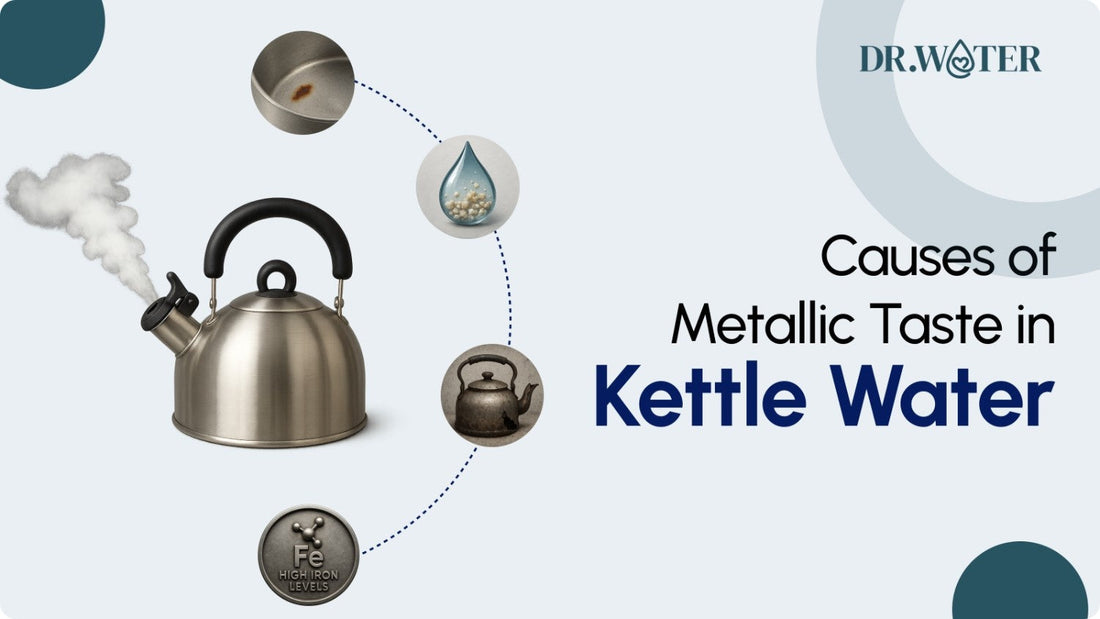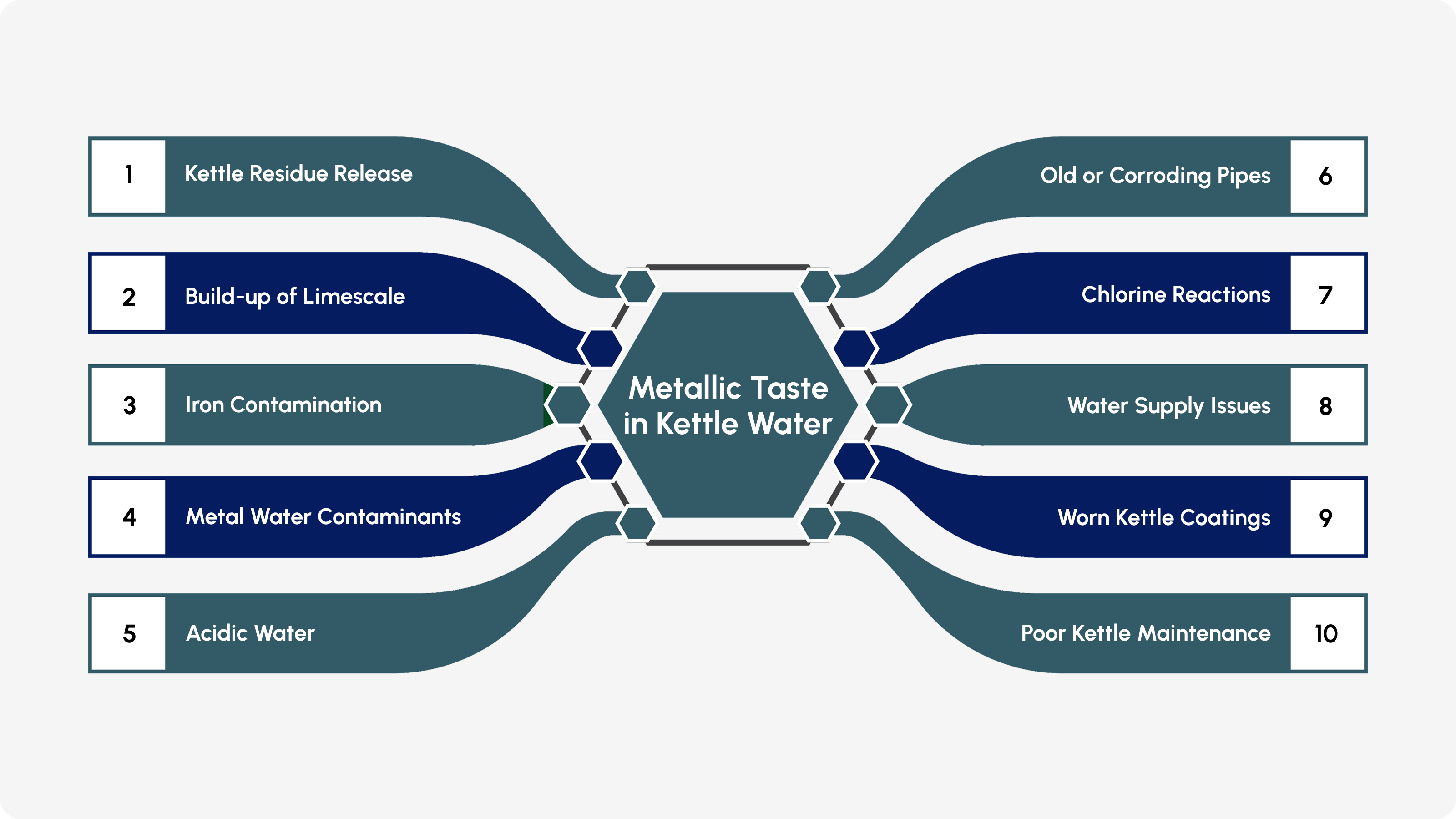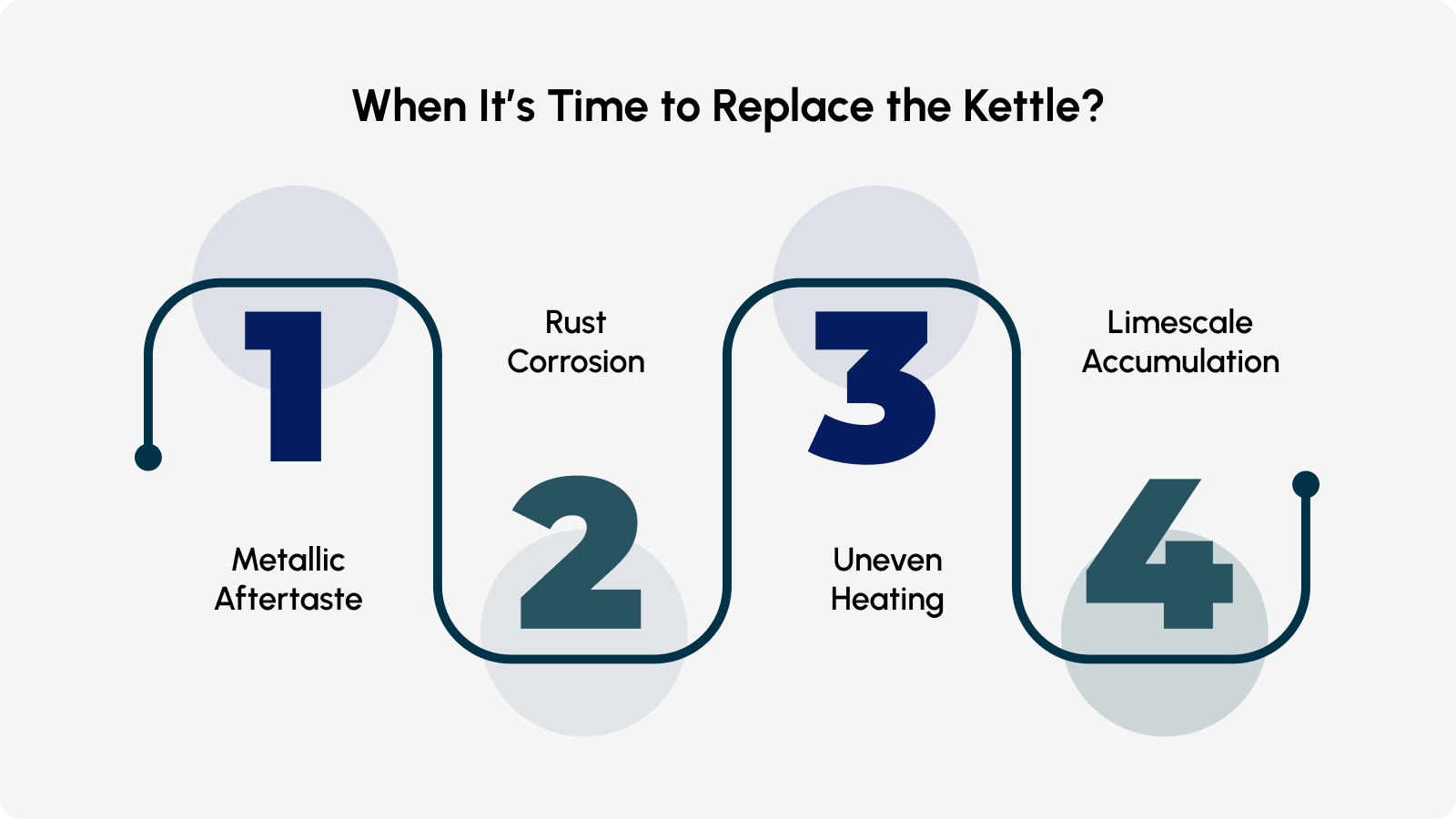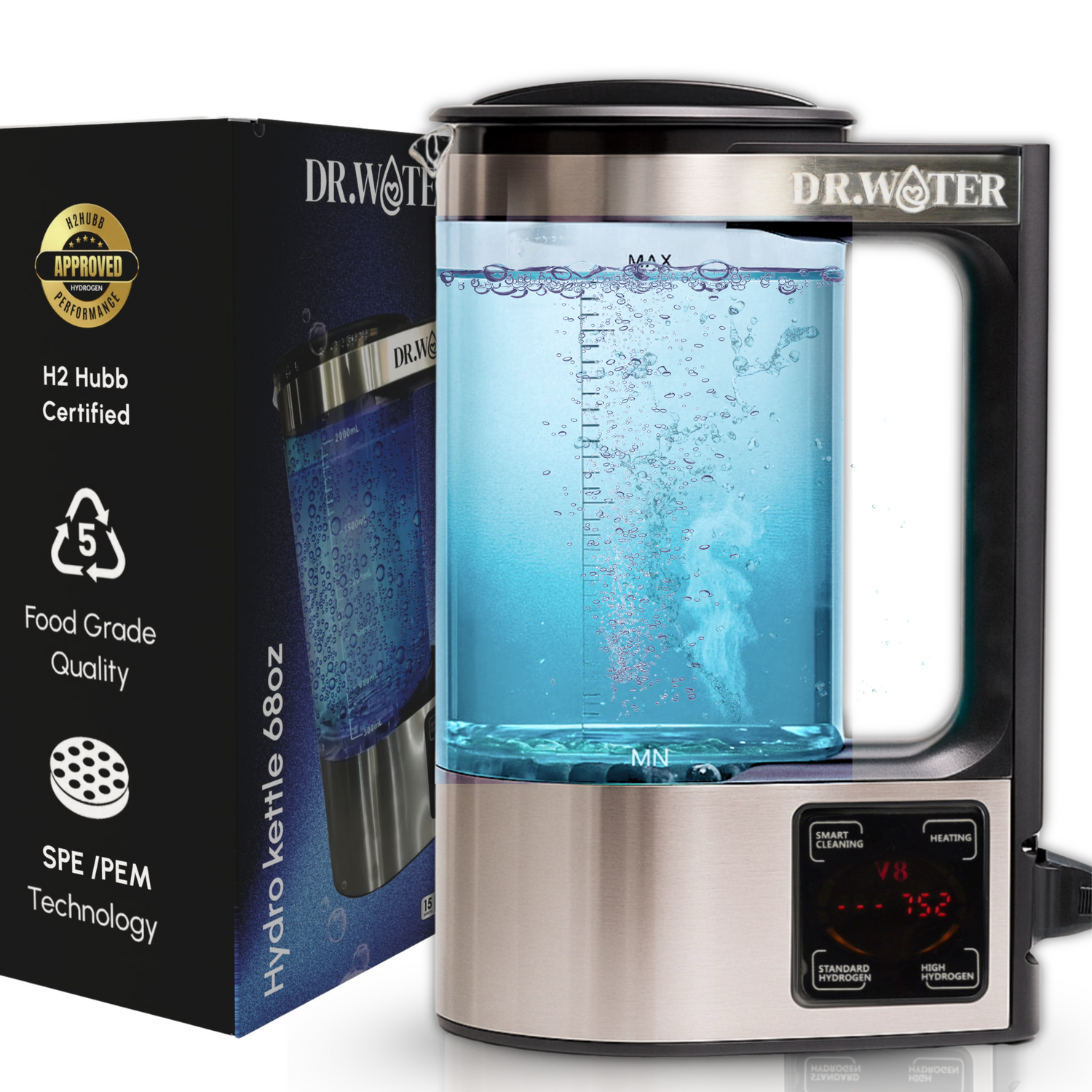
Causes of Metallic Taste in Kettle Water
Share
Summary:
|
Have you ever boiled water in your electric kettle only to be hit with a strange, metallic taste? It’s unpleasant and can make your morning cup of tea or coffee feel like a disappointment. If your electric kettle's water tastes metallic, you’re likely facing an issue that’s more common than you think.
The metallic taste in water is a common problem, but understanding its causes is the first step to fixing it. From the materials inside your kettle to the quality of your water, a number of factors could be at play.
In this blog, we’ll uncover the surprising causes of this metallic taste and offer simple solutions to restore the clean, fresh taste you expect from your kettle.
Understanding the Metallic Taste in Electric Kettle Water
A metallic taste in electric kettle water is something that many people experience, yet it’s often overlooked or dismissed as just a minor inconvenience.
While it might seem like just an unpleasant flavor, a metallic taste can actually be a symptom of a deeper problem, ranging from the kettle’s construction to the water quality or even improper cleaning. Luckily, in most cases, the cause is easy to identify and resolve.
It’s important to first understand why your kettle water might taste metallic. Let’s highlight the most common causes of this issue, helping you pinpoint the root cause and take the necessary steps to eliminate the problem.
9 Causes of Metallic Taste in Kettle Water
When you notice a metallic taste in your electric kettle water, it can be frustrating, especially if you’re used to the clean, fresh taste you expect. This issue can stem from several underlying causes, often related to both the kettle and the water quality.

Below are some common reasons for this, along with the symptoms and strategies for prevention or mitigation.
New Kettle Materials Releasing Residues
When you purchase a new electric kettle, the materials used in its construction, such as stainless steel or aluminum, can release residual oils, chemicals, or coatings left over from manufacturing. This common issue for new kettles typically causes a temporary metallic taste.
Potential Metallic Taste Symptoms:
- A noticeable metallic flavor, especially during the first few uses.
- Lingering aftertaste after boiling the water.
Prevention or Mitigation Strategies:
- Boil water in the new kettle and discard it 2–3 times before using it for drinking purposes.
- Clean the kettle with a vinegar solution or a descaling agent before its first use.
Build-up of Limescale or Mineral Deposits
Over time, hard water can cause limescale or mineral deposits to accumulate inside the kettle. These minerals, particularly calcium and magnesium, can interact with metal components in the kettle and contribute to a metallic taste.
Potential Metallic Taste Symptoms:
- A strong metallic or slightly bitter aftertaste, especially after repeated boiling.
- Increased taste alteration after each use, worsening over time.
Prevention or Mitigation Strategies:
- Regularly descale your kettle using vinegar or a commercial descaling solution to remove mineral buildup.
- Use a water softener or filter to reduce mineral content in your water supply.
High Iron Content in Water
Water with high iron content, commonly found in well water or certain municipal water systems, can give the water a metallic taste. When heated in a kettle, the iron particles can further dissolve and release into the water.
Potential Metallic Taste Symptoms:
- The water has a distinct metallic or rusty flavor, especially when freshly boiled.
- The taste can become more pronounced if the kettle is used frequently with the same water source.
Prevention or Mitigation Strategies:
- Use a water filter that removes iron explicitly from the water.
- Consider using filtered or distilled water to reduce iron content in your kettle.
Other Metal Contaminants in Water
Heavy metals, such as copper or lead, can sometimes find their way into your water supply due to plumbing issues or poor water quality. These metals may be leached into the water, causing a metallic taste, especially when heated.
Potential Metallic Taste Symptoms:
- An off-putting, strong metallic flavor, often described as "sharp" or "bitter."
- Presence of discoloration in the water, such as a cloudy or yellowish tint.
Prevention or Mitigation Strategies:
- Ensure your home’s water supply is tested for heavy metal contaminants.
- Use reverse osmosis or activated carbon filters to remove heavy metals from water before entering the kettle.
Low pH Levels of Water (Acidity)
Water that is too acidic (low pH) can cause it to corrode the interior of a kettle or interact with metal parts, releasing metallic ions that affect the taste of the water.
Potential Metallic Taste Symptoms:
- A sour or metallic taste, especially noticeable in the first few sips after boiling.
- Water may feel "sharp" or unusually bitter when consumed.
Prevention or Mitigation Strategies:
- Check the pH level of your water using a test kit.
- If the water is acidic, use a pH neutralizer or filter that adjusts the pH level before boiling.
Old or Corroding Pipes
If your home’s plumbing system is old or corroded, pipes made of metal can leach particles into the water, resulting in a metallic taste, which can intensify when the water is boiled in a kettle.
Potential Metallic Taste Symptoms:
- A metallic or rusty taste that gets stronger with each use.
- Occasional discoloration of water, often with a brown or reddish hue.
Prevention or Mitigation Strategies:
- Replace old pipes with modern, non-corrosive plumbing materials like PEX or copper.
- Install a whole-house filter to remove metal particles before they reach your kettle.
Chlorine and Chemical Reactions
Some water supplies add chlorine as a disinfectant, which can lead to a chemical reaction when heated in a kettle, especially if the kettle is made of metal. This can leave a metallic taste in the water.
Potential Metallic Taste Symptoms:
- A chlorine-like metallic flavor, especially if the water has been boiled for a long time.
- Water may smell like bleach or chemicals.
Prevention or Mitigation Strategies:
- Let the water sit for a few minutes before boiling to allow chlorine to dissipate.
- Use a carbon filter to remove chlorine and other chemicals from your water.
Water Supply Issues
Occasionally, issues with the municipal water supply, such as contamination or improper treatment, can result in metallic-tasting water. This can happen when the water treatment plant uses insufficient filtration processes or is dealing with outdated equipment.
Potential Metallic Taste Symptoms:
- Sudden onset of metallic taste without any changes to the kettle or water source.
- A metallic flavor that lasts despite regular cleaning and maintenance.
Prevention or Mitigation Strategies:
- Contact your local water authority to report unusual taste or water quality concerns.
- Use a high-quality filter to remove contaminants that municipal systems might not fully address.
Inadequate or Worn Interior Kettle Coatings
The interior coating of an electric kettle, especially in cheaper models, may wear down over time. This can expose metal components to water, leading to the release of metallic particles that affect the taste of the water.
Potential Metallic Taste Symptoms:
- A noticeable metallic or "off" flavor after frequent use.
- Increased taste intensity if the kettle is old or has been overused.
Prevention or Mitigation Strategies:
- Replace old kettles with newer models that feature durable, non-reactive interiors.
- Ensure that the kettle is appropriately maintained and that the coating is intact.
Insufficient Kettle Cleaning and Maintenance
If you neglect regular cleaning, food particles, limescale, or even mold can accumulate in the kettle, which can cause the water to taste metallic.
Potential Metallic Taste Symptoms:
- A stale or metallic flavor that improves after a fresh cleaning.
- The taste may fluctuate depending on the level of cleaning and use.
Prevention or Mitigation Strategies:
- Clean the kettle at least once a month using vinegar or a descaling product.
- Ensure thorough cleaning of all internal components, including the heating element.
When It’s Time to Replace the Kettle
If cleaning, filtering, and regular maintenance don’t resolve the issue, it might be time to consider replacing your kettle.

Here are some signs that indicate a new kettle might be the best solution:
- Persistent Metallic Taste: If the metallic taste persists even after cleaning, it may be a sign that your kettle’s internal components are deteriorating or corroding.
- Visible Rust or Corrosion: Any visible signs of rust or corrosion inside the kettle are a clear indication that it's no longer safe to use. Corroded metal can leach harmful substances into your water.
- Uneven Heating: If your kettle is no longer heating water evenly or efficiently, it's time for a replacement. Poor performance could mean there are underlying issues with the kettle’s heating elements.
- Frequent Build-Up of Limescale: If your kettle continuously accumulates limescale despite regular cleaning, it could be a sign of damage to the interior coating or metal components, affecting the taste and quality of water.
If you're tired of dealing with unpleasant, metallic-tasting water, it might be time to upgrade to a Dr. Water hydrogen-infused kettle. Dr. Water offers the latest in water technology, transforming your tap water into antioxidant-rich, purified water with every boil.
Say Goodbye to Metallic Tastes with Dr. Water
If you've been battling that persistent metallic flavor in your kettle water, it's time to upgrade your hydration experience. Dr. Water offers a range of innovative hydrogen-infused water bottles and kettles (which heat water but do not boil it), designed to enhance taste, support health, and eliminate unwanted flavors.
Why Choose Dr. Water?
- Advanced Hydrogen Infusion: Utilizing cutting-edge SPE and PEM technology, Dr. Water products enrich your water with molecular hydrogen, known for its antioxidant properties.
- Premium Build Quality: Crafted from BPA-free Tritan and borosilicate glass, ensuring durability and purity in every sip.
- User-Friendly Design: Features like self-cleaning modes and rapid hydrogenation cycles make maintenance effortless.
- Scientifically Backed Benefits: Hydrogen water has been linked to reduced inflammation, improved hydration, and enhanced antioxidant intake.
Explore Our Top Products:
- HydroStanley 32oz: A portable bottle delivering up to 2500 PPB hydrogen concentration, perfect for daily use.
- HydroKettle 68oz: A family-sized kettle that transforms ordinary tap water into hydrogen-rich water in just 5 minutes.
- HydroUV 14oz: Combines UV-C sterilization with hydrogen infusion, ensuring clean and healthy hydration on the go.
Don't let metallic-tasting water affect your health and well-being. Experience the difference with Dr. Water's innovative products. Visit drwater.store today to find the perfect solution for your hydration needs.
Conclusion
If your electric kettle's water tastes metallic, understanding the root causes can help you address the issue quickly. Regular cleaning, using filtered water, and replacing old kettles when necessary can prevent these metallic tastes and ensure better-tasting water for all your needs.
By investing in regular maintenance and high-quality products like those offered by Dr. Water, you can avoid the metallic taste and enjoy water that’s pure, fresh, and full of health benefits.
Ready to elevate your hydration? Experience the difference with Dr. Water’s premium hydrogen-infused kettles that heat water and are designed to give you the healthiest, best-tasting water. Visit Dr. Water now to find the perfect solution for your water needs and start enjoying metallic-free hydration today!

